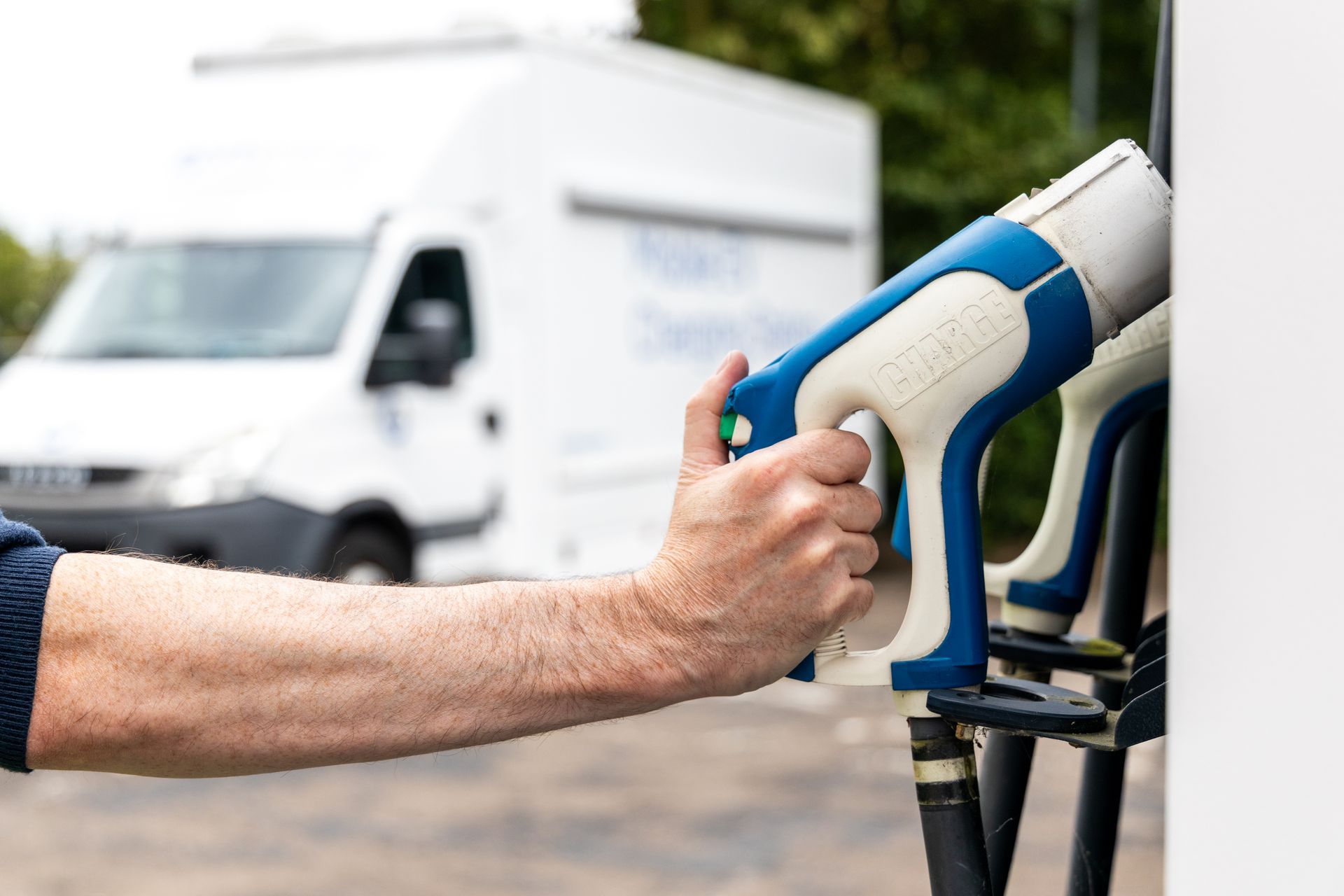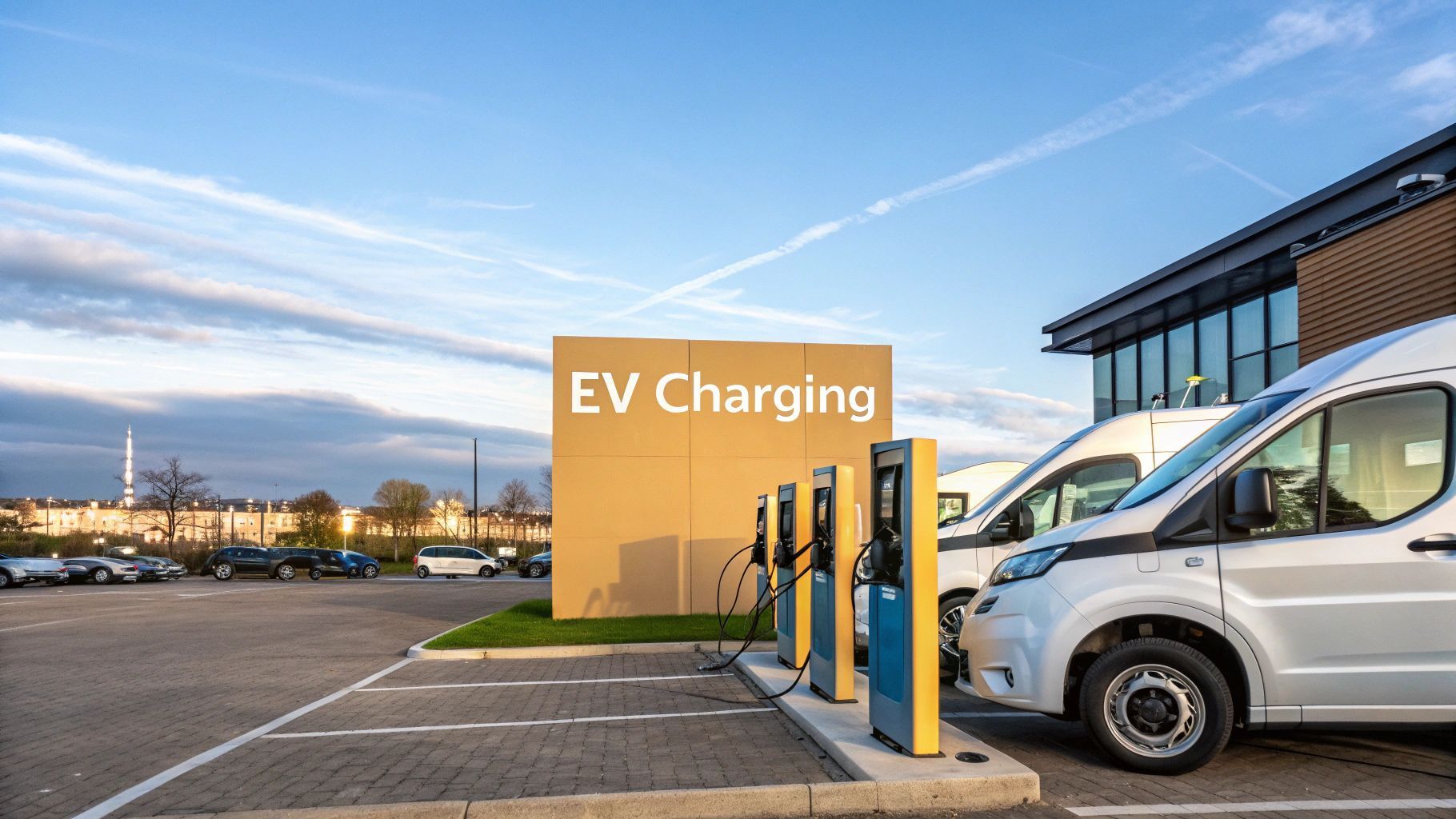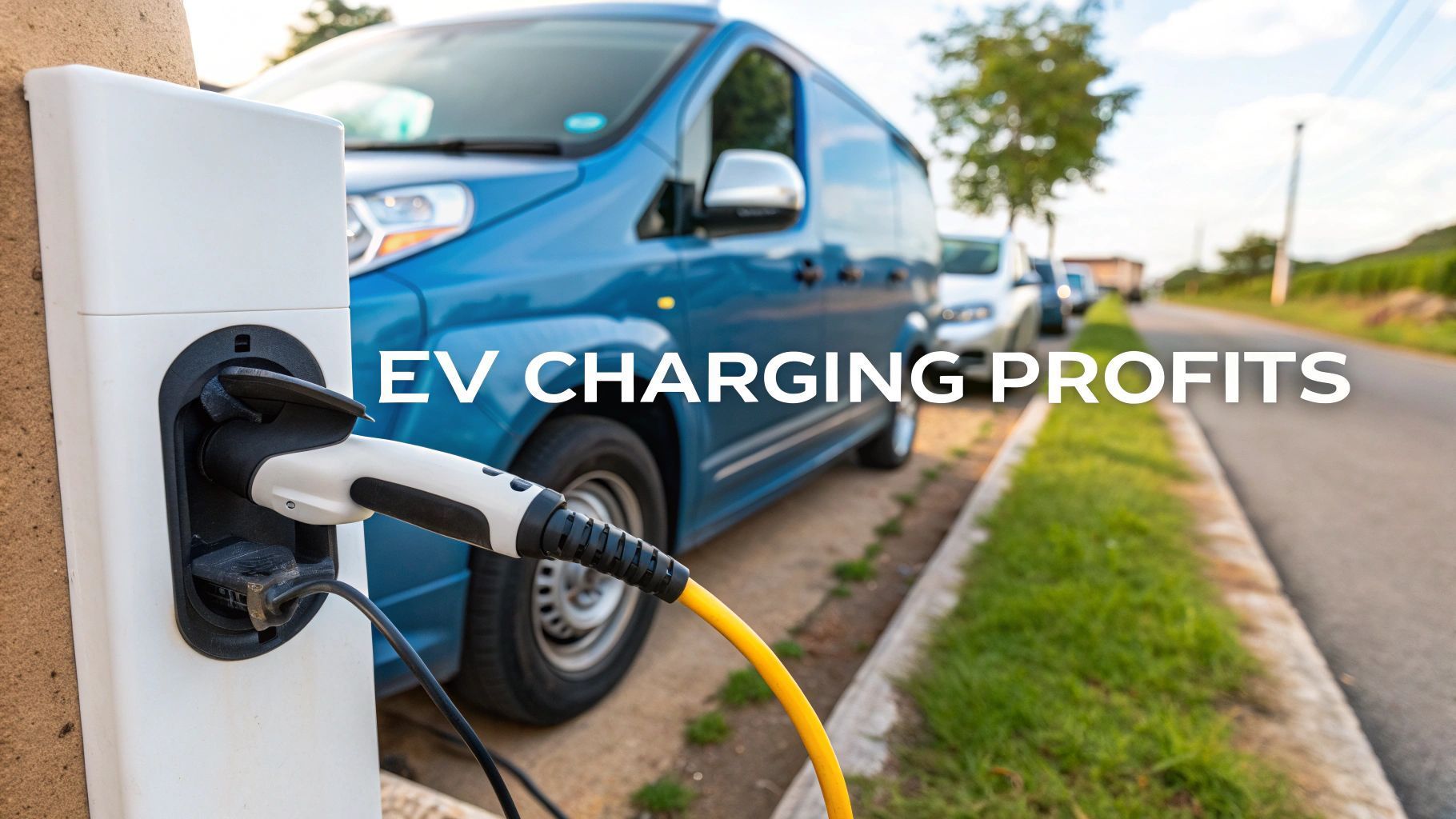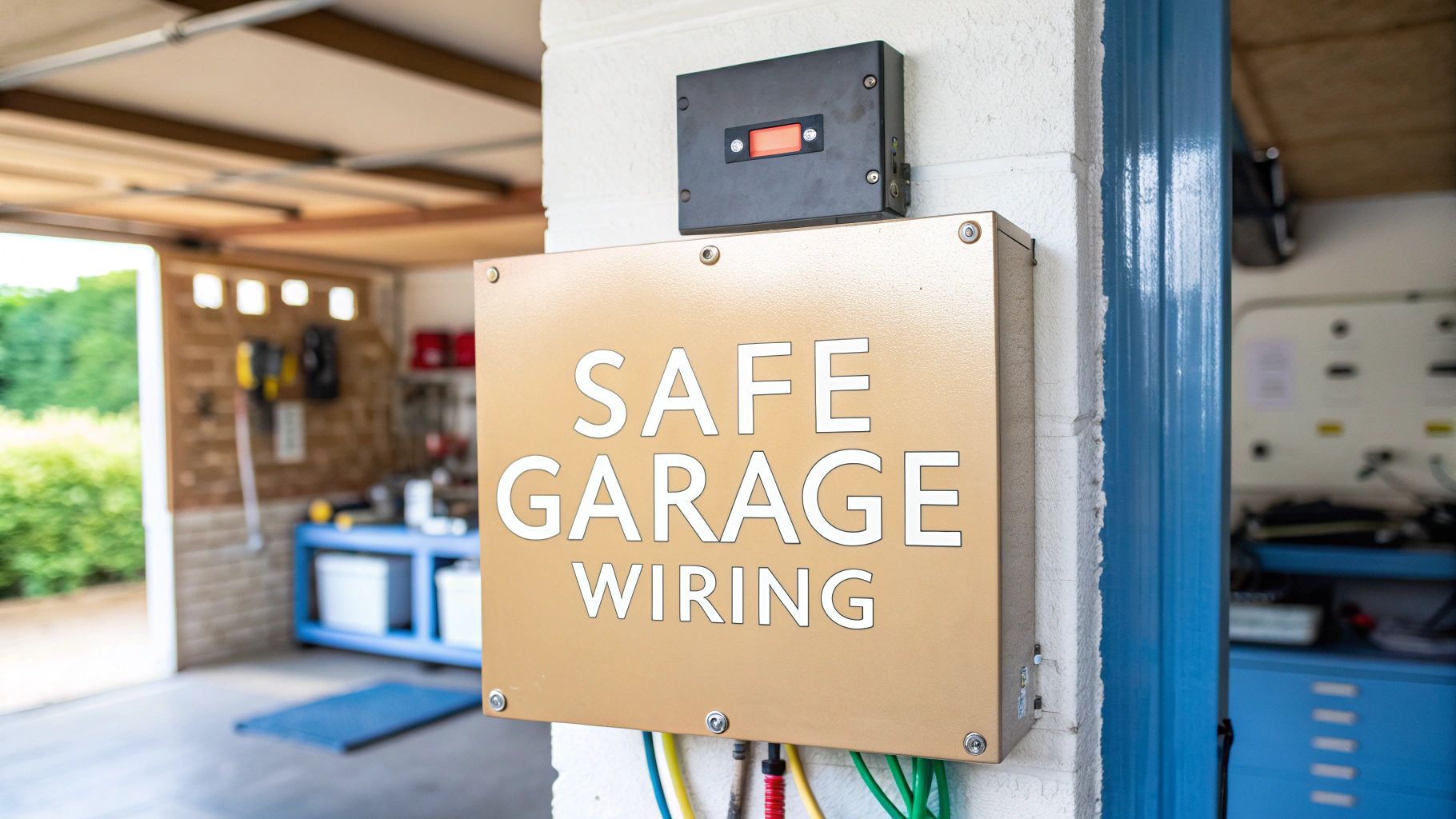A Guide to the Types of Electric Vehicles
Diving into the world of electric vehicles can feel a bit like learning a new language. You have got acronyms flying around everywhere but it is simpler than it sounds. At its core, you are looking at three main flavours: Battery Electric Vehicles (BEVs) , which are 100% electric; Plug-in Hybrids (PHEVs) , which mix a battery with a good old petrol engine; and Hybrid Electric Vehicles (HEVs) , which use a petrol engine that gets a little boost from a self-charging electric motor.
Decoding the Jargon of Electric Vehicles
The UK’s roads are changing fast. More and more drivers are making the switch to electric, chasing lower running costs and a cleaner conscience. But before you can join them, you need to get your head around the terminology. Those acronyms—BEV, PHEV, HEV—are just a shorthand for how a car uses (or does not use) petrol.
And this is not some far-off trend; it is happening right now. The UK's EV market is booming, especially for BEVs and PHEVs. Just last September, BEV registrations hit 72,779 units, a massive 29.1% jump from the year before. PHEVs did even better, with registrations soaring by 56.4% to 38,308 units. This surge is a clear sign that drivers are ready for cleaner cars, helped along by government incentives. You can dig into the numbers yourself in the latest SMMT vehicle data.
The Main EV Categories
The easiest way to make sense of it all is to picture a spectrum. On one end, you have cars that are fully electric and on the other, cars that just use a little bit of electric assistance. Each type strikes a different balance between electric range, the convenience of filling up at a petrol station and how much you rely on the grid.
This infographic breaks down the basic hierarchy of the most common types of electric vehicles you will spot on UK roads.
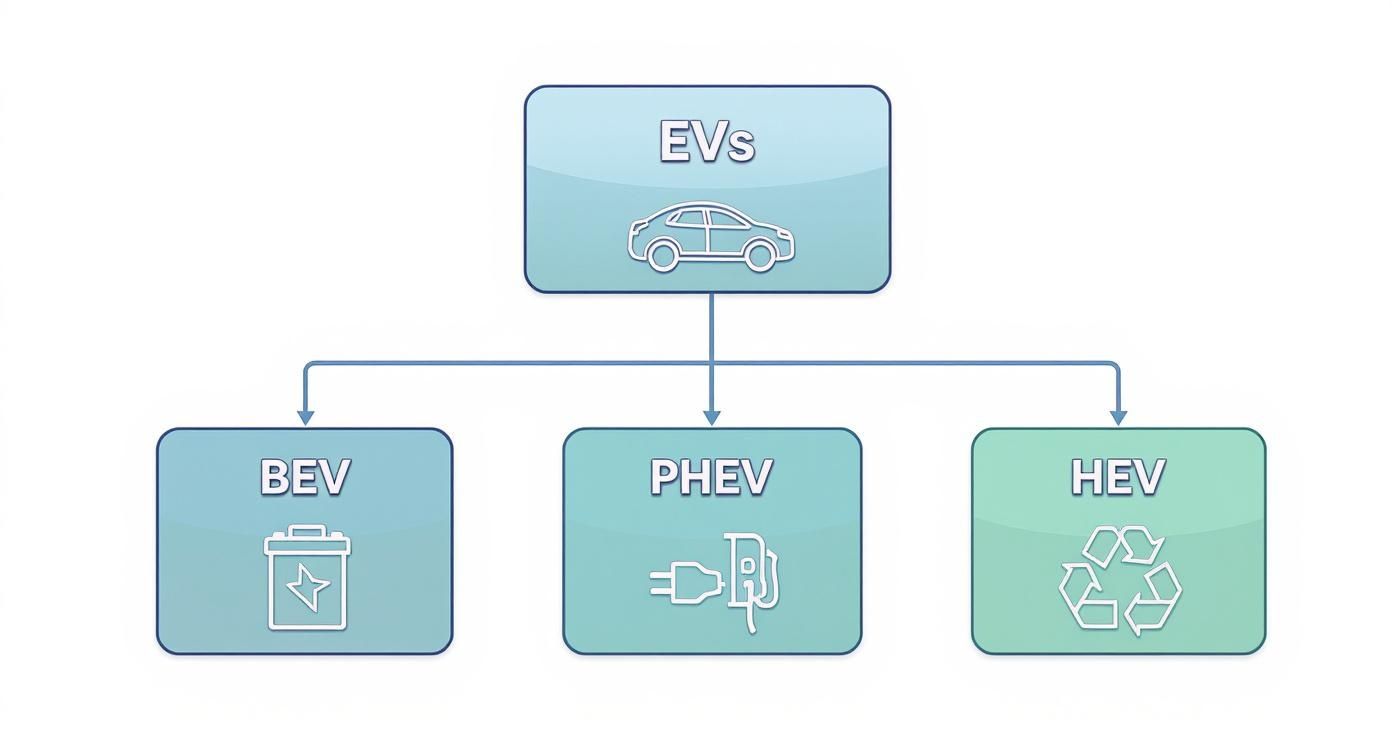
As you can see, the diagram neatly splits EVs into three core groups based on how they are powered, showing the fundamental differences between them. Before we get into the nitty-gritty of each type, it might be helpful to get familiar with some of the key terms in our complete EV charging glossary.
Quick Comparison of Electric Vehicle Types
To give you a quick overview, this table summarises the key differences between the main categories of electric vehicles. Think of it as a handy cheat sheet to see how they stack up at a glance.
| Vehicle Type | Primary Power Source | External Charging Required | Typical Electric Range |
|---|---|---|---|
| BEV | Electric Battery | Yes (Must be plugged in) | 150 - 300+ miles |
| PHEV | Battery & Petrol Engine | Yes (For electric range) | 20 - 50 miles |
| HEV | Petrol Engine & Battery | No (Self-charging) | 1 - 2 miles (assist only) |
Each of these vehicle types is designed for a slightly different kind of driver and lifestyle, which we will explore in more detail next.
Battery Electric Vehicles: The All-Electric Choice
Battery Electric Vehicles, or BEVs, are what most people picture when they think of an EV. They represent the purest form of electric motoring, running entirely on electricity stored in a large battery pack. Think of it as a high-tech fuel tank but instead of petrol, it holds the energy that powers an electric motor to turn the wheels.
The result is a driving experience that is incredibly smooth, quiet and responsive. With no petrol engine to fall back on, BEVs produce zero tailpipe emissions, which is fantastic news for improving air quality in our towns and cities. This simpler design, with far fewer moving parts, also means running and maintenance costs are significantly lower than for traditional cars.
Understanding BEV Charging and Range
One of the first questions drivers ask is about charging. You can top up a BEV in several ways and each fits a different situation. For most owners, home charging overnight with a dedicated wallbox is the easiest and cheapest method. It is just like plugging in your phone before bed—you wake up with a "full tank" every morning.
Public charging stations are also popping up everywhere, from supermarket car parks to dedicated charging hubs across the UK. These offer much faster charging speeds than you would get at home. For those long journeys, rapid chargers at motorway services can add over 100 miles of range in as little as 20-30 minutes , depending on your car and the charger. To get a better grasp of the power sources and refuelling methods for EVs, it is worth exploring the core advancements in battery and charging technologies.
"While range anxiety was a common concern in the early days of EVs, modern BEVs now offer ranges of over 300 miles on a single charge, making them perfectly capable of handling daily commutes and long-distance travel with ease."
Of course, knowing which plug your car uses is vital for compatibility. Our comprehensive guide covers every type of EV charging plug to help you make sense of the different standards out there.
The Benefits and Considerations
The upsides of choosing a BEV go far beyond just saving on fuel. Here are some of the key benefits:
- Zero Tailpipe Emissions: BEVs produce no harmful exhaust fumes, directly contributing to cleaner air.
- Lower Running Costs: Electricity is cheaper per mile than petrol and with fewer mechanical parts, servicing is often simpler and less expensive.
- Government Incentives: UK drivers can benefit from tax exemptions and grants that make ownership more affordable.
- A Quieter Drive: The near-silent operation of an electric motor creates a more relaxing and refined driving experience.
However, there are a few things to keep in mind. Charging still takes longer than filling a petrol tank and long trips require a bit of planning around rapid charger locations. While the public network is growing quickly, it is not yet as widespread as petrol stations, especially in more rural areas.
Plug-In Hybrids: The Bridge to All-Electric
For drivers curious about going electric but not quite ready to ditch petrol entirely, the Plug-in Hybrid Electric Vehicle (PHEV) offers a fantastic middle ground. It is often called the "best of both worlds" for a reason.
Think of it as having two cars in one. A smaller battery and electric motor handle your daily driving, while a traditional petrol engine is always ready for longer trips.
You can do the daily commute, the school run or a trip to the shops using nothing but quiet, clean electric power. Most PHEVs offer a pure electric range of 20 to 50 miles , which easily covers the average daily drive in the UK. But when you need to head further afield, the petrol engine kicks in seamlessly, completely removing any worries about finding a charger on a long motorway journey.
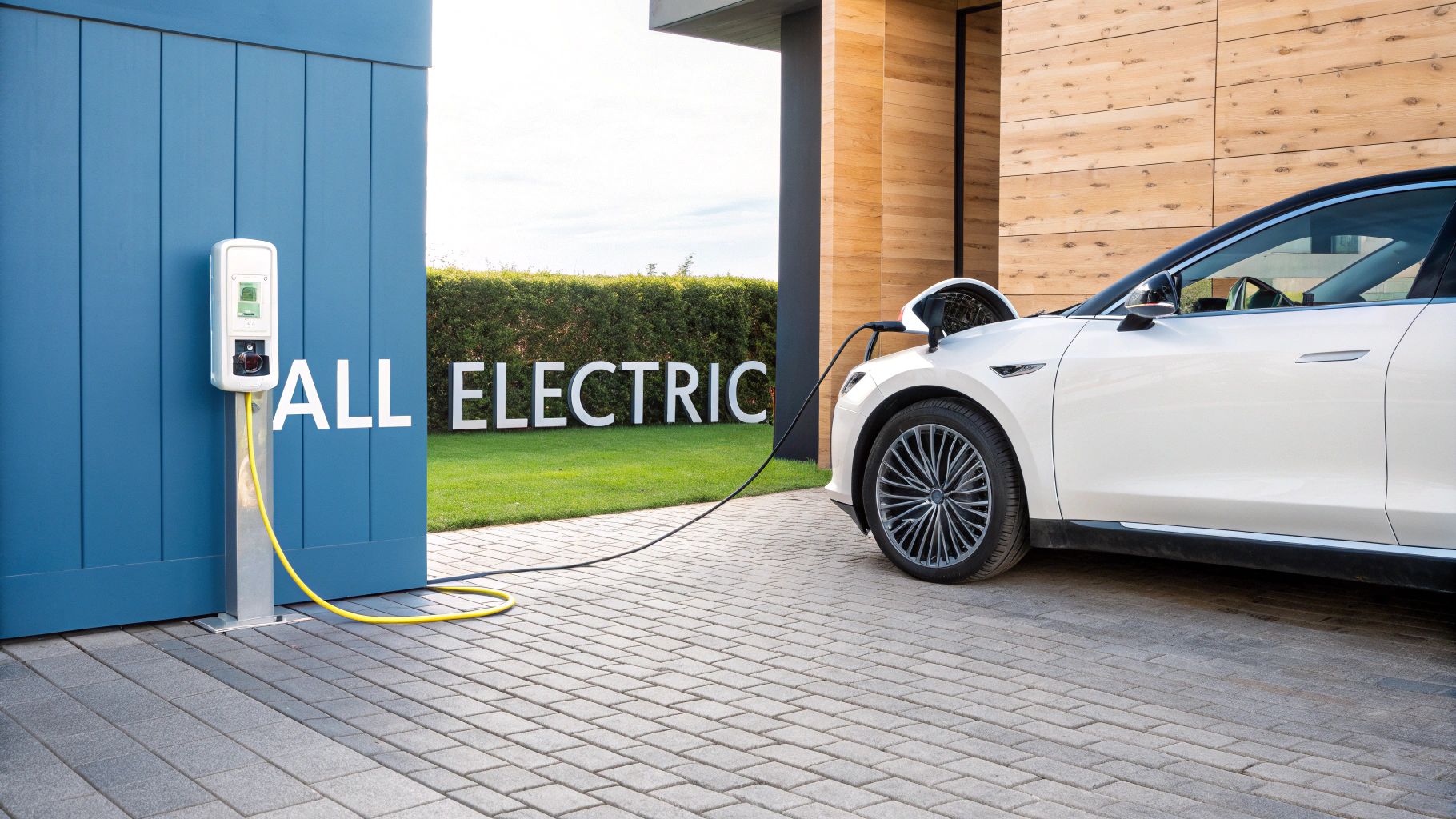
Combining the Best of Both Worlds
The biggest draw for a PHEV is its ability to eliminate the dreaded range anxiety that can put some people off buying a fully electric car. With the petrol engine as a reliable backup, spontaneous long-distance journeys are never a problem. This makes PHEVs an incredibly practical choice for single-car households that need a vehicle to do a bit of everything.
This versatility has made PHEVs a popular choice across Europe. In fact, electric vehicle sales reached over a fifth of the market in August last year, with both pure electrics and PHEVs driving this growth. This trend reflects a broader shift towards electrification that is also happening right here in the UK, helped along by the growing popularity of brands like MG and BYD. You can find more insights into the European car market on best-selling-cars.com.
Advantages and Disadvantages of PHEVs
While PHEVs offer brilliant flexibility, it is worth weighing up the pros and cons to see if one really fits your lifestyle.
Key Advantages:
- Reduced Emissions: Your daily driving can be done on electric power, producing zero tailpipe emissions.
- Lower Fuel Costs: Using cheap overnight electricity for short trips significantly cuts down your reliance on expensive petrol.
- No Range Anxiety: The petrol engine gives you total peace of mind for longer journeys, a key factor in curing electric vehicle range anxiety for UK drivers.
- A Gentle Transition: They offer a taste of electric driving without forcing you to completely change your habits overnight.
Of course, PHEVs are not without their drawbacks. Because they have both an engine and a motor, they are mechanically more complex than a pure EV, which could mean more maintenance down the line. You will also still need to buy petrol for longer trips and their fuel economy can be less impressive once the battery is empty.
Self-Charging Hybrids: The Original Eco-Car
Long before fully electric cars became a common sight, Hybrid Electric Vehicles (HEVs) were already paving the way for more fuel-efficient driving. You might know them better by their marketing name: ‘self-charging hybrids’. These were the original pioneers, blending familiar petrol power with a little electric assistance.
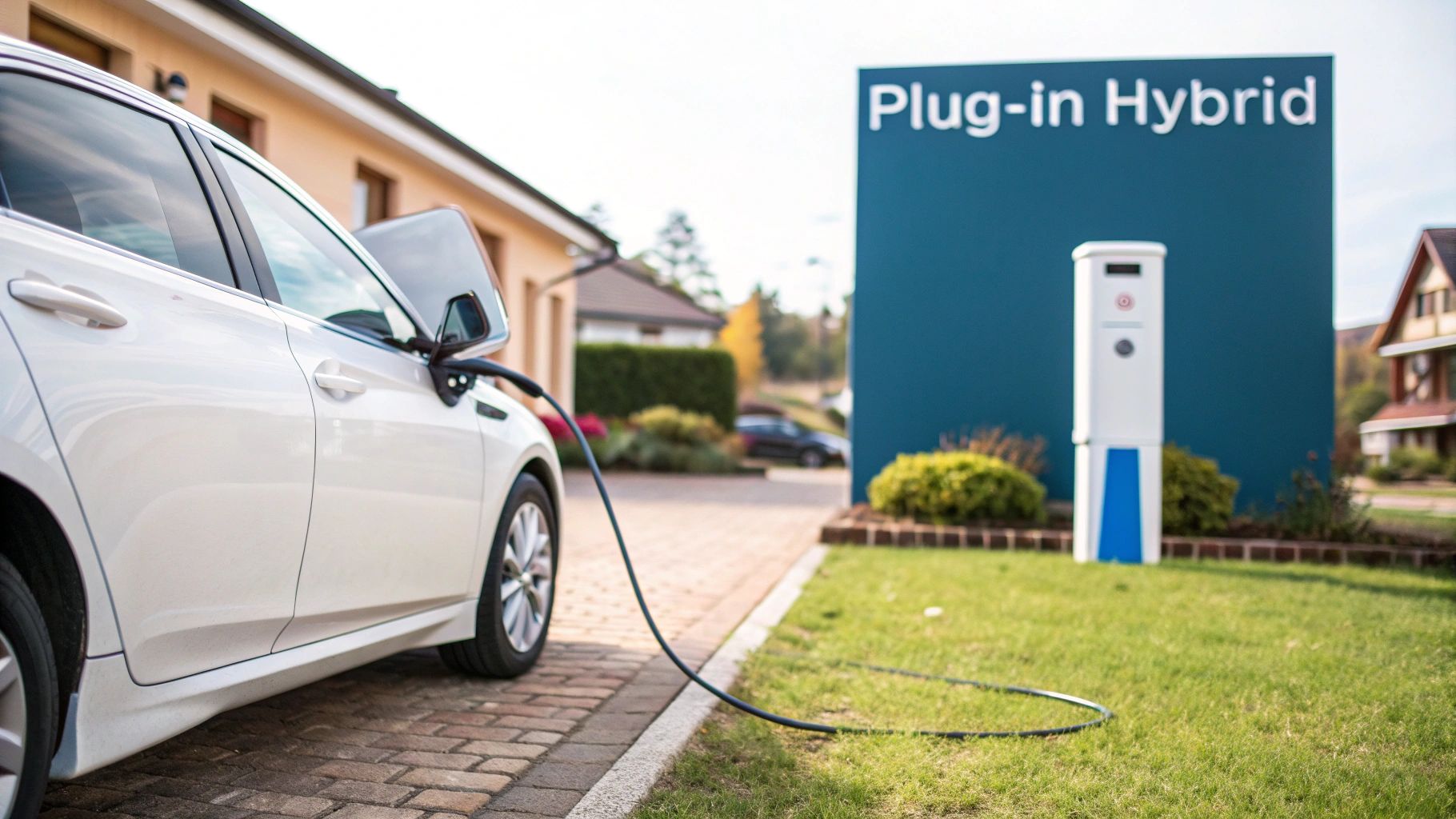
Unlike their fully electric or plug-in cousins, you cannot plug an HEV into a wall socket or a public charger. Instead, they have a small battery that gets topped up by the petrol engine and through a clever process called regenerative braking .
This system is pretty neat—it captures the energy that is normally lost as heat when you slow down and converts it back into electricity. That electricity is then stored in the battery, ready to be used again.
The stored energy powers an electric motor that gives the petrol engine a helping hand, especially when you are accelerating or driving at low speeds. The result? A noticeable improvement in fuel efficiency compared to a standard petrol car, all without asking you to change a single driving habit.
How HEVs Deliver That Extra Efficiency
The real magic of an HEV is how seamlessly it switches between its two power sources—or uses them both at the same time—to squeeze the most out of every litre of fuel. The car's computer handles all of this automatically.
For example, when you are pulling away from a traffic light or crawling through a jam, the electric motor can take over completely for very short distances, maybe a mile or two at most. This is huge, as it cuts down on fuel use during the least efficient parts of any journey. As your speed picks up, the petrol engine smoothly kicks in to take over, recharging the battery as it goes.
The biggest selling point here is the sheer simplicity for the driver. You just fill it up with petrol and drive it like any other car. The hybrid tech just works away quietly in the background, saving you money and cutting down your emissions.
The Pros and Cons of Self-Charging
HEVs offer a fantastic, gentle introduction to the world of electrified driving but it is important to know where they shine and where they fall short. Think of them as a big step up from a traditional car but not a zero-emissions solution.
Key Advantages:
- Improved Fuel Economy: You will consistently get better miles per gallon than in a comparable non-hybrid, which means fewer trips to the petrol station.
- No Behavioural Change Needed: There is no learning curve. You do not need to install a home charger or plan your routes around public charging points.
- Lower Purchase Price: HEVs are generally more affordable to buy outright than Plug-in Hybrids (PHEVs) or Battery Electric Vehicles (BEVs).
Key Disadvantages:
- Limited Electric-Only Driving: The inability to travel more than a mile or two on pure electric power is a significant limitation. You are mostly just assisting the engine.
- Still Reliant on Fossil Fuels: At the end of the day, an HEV still needs petrol to run and will always produce tailpipe emissions.
Cashing In on Convenience: The Business of Mobile EV Charging
The growing number of electric vehicles on UK roads has naturally sparked new business opportunities. One of the most exciting is mobile EV charging—think of it as a power bank on wheels, ready to rescue stranded drivers or top up cars in places that fixed chargers cannot reach. This is far more than just a roadside recovery gimmick; it is a fully-fledged business model with some serious financial clout.
The real genius of this service is that it directly tackles two of the biggest roadblocks to EV adoption: range anxiety and the lack of off-street parking. For the millions of UK households without a driveway, home charging is simply off the table. Mobile charging flips the script by bringing the power directly to the customer’s kerb, offering a genuinely convenient on-demand solution.
Unlocking Powerful Revenue Streams
What makes a mobile charging operation financially solid is its mix of flexible and diverse income streams. An operator is not stuck with a single pricing model. Instead, they can blend several approaches to boost profitability and meet different customer needs.
A successful mobile charging business can be built on three core pillars:
- Per-kWh Energy Sales: This is the most straightforward model. Customers pay for the electricity they use, just like at a public charging station but with a premium added for the sheer convenience of a kerbside service.
- Emergency Call-Out Fees: For drivers who have run completely flat, a fixed call-out fee generates immediate, high-margin income. This kind of emergency service is invaluable and naturally commands a higher price.
- Subscription Services: Offering monthly or annual subscriptions to fleet operators, taxi firms or even entire apartment blocks creates a steady and predictable flow of recurring revenue.
This blend of income ensures a consistent cash flow, balancing one-off emergency calls with reliable contract work. It is this adaptability that makes mobile charging such a resilient business in the ever-changing EV world.
A Realistic Look at the Financials
So, what can a mobile charging operator realistically expect to make? Let us crunch the numbers with a conservative projection for a single van and operator.
Imagine an operator manages to complete just 10 charges per day . With a smart pricing structure, the income potential quickly becomes clear.
A mobile charging business can generate substantial income. For example, charging a modest £1.00 per kWh and delivering an average of 25 kWh per vehicle , an operator completing just 10 charges daily could bring in £250 per day or over £6,000 per month from energy sales alone.
And remember, that figure does not even touch on the other high-value income streams.
Building on the Core Business
To paint a fuller picture, let us factor in those other revenue sources that can significantly boost the bottom line.
| Revenue Stream | Estimated Daily Income (Example) | Notes |
|---|---|---|
| Energy Sales | £250 (10 charges x 25 kWh x £1.00) | The primary source of consistent income. |
| Call-Out Fees | £120 (2 calls x £60 fee) | Emergency services offer high-profit margins. |
| Subscription Fees | £50 (Pro-rated daily from contracts) | Provides a stable, predictable revenue base. |
Based on these sensible estimates, a single operator could generate a daily revenue of £420 . That translates to an annual turnover of more than £150,000 . Once you subtract operational costs like fuel, insurance and vehicle maintenance, the net profit remains incredibly attractive, proving that mobile charging is a seriously lucrative venture in the UK's expanding EV ecosystem.
Hydrogen Fuel Cell Cars: A Glimpse of the Future?
Beyond batteries and hybrids lies another fascinating corner of the electric vehicle world: Fuel Cell Electric Vehicles (FCEVs) . These cars run on hydrogen but do not be mistaken – they are still very much electric. Think of them as carrying their own clean power plant, using hydrogen to generate electricity on the move.
The only thing that comes out of the exhaust? Pure water.
In many ways, this technology promises the best of both worlds. FCEVs give you the silent, zero-emission driving you get from a pure EV but with the convenience of a traditional petrol car. The refuelling process is a massive advantage, as filling a hydrogen tank takes just a few minutes – a far cry from even the fastest BEV charging times.
Compelling Advantages Meet Real-World Hurdles
With driving ranges often pushing past 300 miles on a single tank, FCEVs seem perfectly built for long-distance journeys without the long waits. It is an exciting prospect for the future of clean transport but their path to becoming a common sight on UK roads is blocked by a couple of major obstacles.
For a start, the technology is not cheap. The cars themselves are expensive to make and buy and the price of hydrogen fuel is still considerably higher than topping up with electricity. Until those costs come down, it is a tough sell for the average driver.
The biggest challenge for FCEVs, however, is infrastructure. The network of hydrogen refuelling stations is tiny compared to both petrol stations and electric chargers, making them impractical for most people today.
Until these hurdles are cleared, FCEVs will likely remain a forward-looking technology rather than a mainstream choice for UK drivers.
Common Questions About EV Types
Choosing your first electric vehicle can feel like navigating a maze of acronyms and new technology. As you start comparing pure electrics with the various shades of hybrid, a few key questions nearly always pop up. This final section is all about tackling those common queries head-on to help you make a confident decision.

We will break down the answers in simple terms, giving you the clarity you need to pick the perfect EV for your life in the UK.
Which EV Type Is Cheapest to Run in the UK?
When you look at the total cost of ownership in the UK, a Battery Electric Vehicle (BEV) almost always comes out on top. While the initial sticker price might be a bit higher than a hybrid, the day-to-day savings really start to stack up.
BEVs run on electricity, which is far cheaper than petrol or diesel, especially if you can charge at home overnight on an off-peak tariff. They also have far fewer moving parts in the engine, meaning servicing bills are lower. Plus, BEV owners currently enjoy exemptions from road tax (VED) and clean air zone charges, costs that many hybrid owners still have to pay.
Can I Own a BEV Without a Home Charger?
Absolutely, but it does require a bit more forward planning. Relying purely on the public charging network is perfectly doable, particularly for those living in towns and cities with good infrastructure. The main trade-off is that it is almost always more expensive than charging up at home.
For drivers without a driveway or dedicated parking spot, the public network is the only game in town. It means planning your week around top-ups at the supermarket or a rapid charge at the motorway services, often at a higher price per kWh. This is where on-demand mobile charging is becoming a real game-changer, bringing the convenience of a charge right to your kerbside.
How Does UK Charging Infrastructure Support Different EVs?
The UK’s public charging network is built to handle all plug-in vehicles but it is not a one-size-fits-all system. Different chargers are designed for different vehicles and situations.
- Slow Chargers (Up to 3kW): These are perfect for overnight charging at home. They work well for both BEVs and PHEVs , gently topping up the battery over several hours.
- Fast Chargers (7-22kW): You will find these in public car parks, supermarkets and workplaces. They are great for adding a decent amount of range to a BEV over a few hours while you are busy elsewhere.
- Rapid & Ultra-Rapid Chargers (50kW+): These are the big guns, designed for BEVs on long journeys. They can add a significant chunk of range in well under an hour. It is worth remembering that most PHEVs cannot use these high-powered chargers.
For businesses and drivers who need dependable charging without being tied to a fixed point, ZAPME offers powerful mobile solutions. Discover how our on-demand services can support your electric journey at https://www.zapme.biz.

